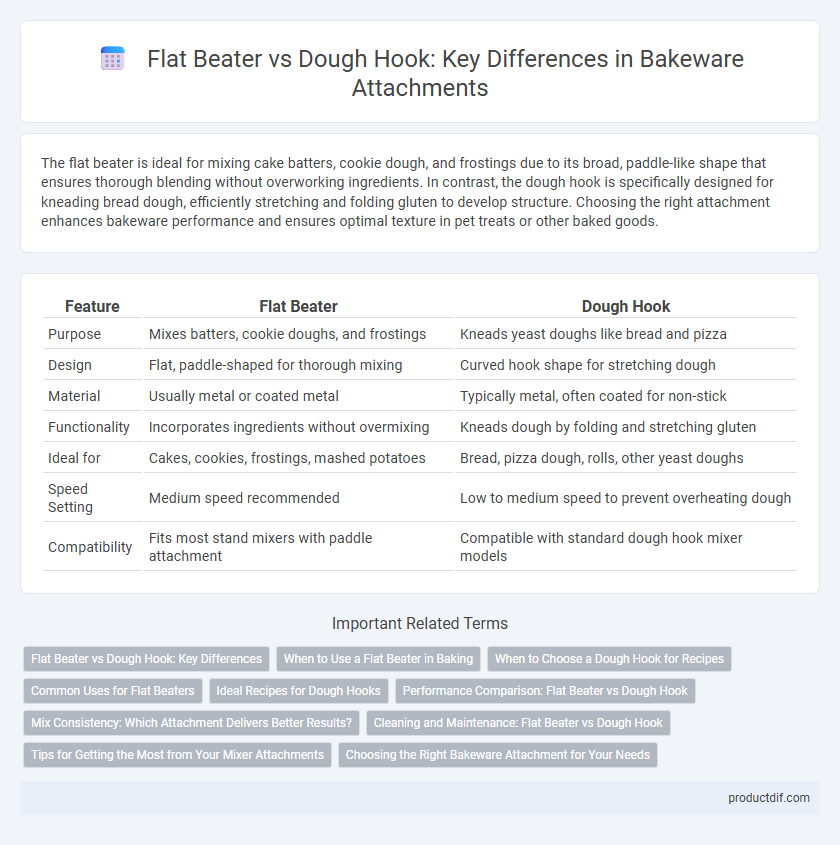The flat beater is ideal for mixing cake batters, cookie dough, and frostings due to its broad, paddle-like shape that ensures thorough blending without overworking ingredients. In contrast, the dough hook is specifically designed for kneading bread dough, efficiently stretching and folding gluten to develop structure. Choosing the right attachment enhances bakeware performance and ensures optimal texture in pet treats or other baked goods.
Table of Comparison
| Feature | Flat Beater | Dough Hook |
|---|---|---|
| Purpose | Mixes batters, cookie doughs, and frostings | Kneads yeast doughs like bread and pizza |
| Design | Flat, paddle-shaped for thorough mixing | Curved hook shape for stretching dough |
| Material | Usually metal or coated metal | Typically metal, often coated for non-stick |
| Functionality | Incorporates ingredients without overmixing | Kneads dough by folding and stretching gluten |
| Ideal for | Cakes, cookies, frostings, mashed potatoes | Bread, pizza dough, rolls, other yeast doughs |
| Speed Setting | Medium speed recommended | Low to medium speed to prevent overheating dough |
| Compatibility | Fits most stand mixers with paddle attachment | Compatible with standard dough hook mixer models |
Flat Beater vs Dough Hook: Key Differences
Flat beater and dough hook are essential attachments for stand mixers, each designed for specific baking tasks. Flat beaters excel at mixing cake batter, cookie dough, and normal to heavy mixtures, providing thorough blending without overworking the ingredients, while dough hooks are specialized for kneading yeast doughs like bread and pizza, efficiently developing gluten structure. Understanding the key differences in shape, function, and application helps bakers select the right tool to achieve optimal texture and consistency in their baked goods.
When to Use a Flat Beater in Baking
Use a flat beater in baking for mixing cake batters, cookie doughs, and frostings where a smooth, uniform texture is essential. It excels at incorporating ingredients without overworking the mixture, ensuring airy and tender results. Avoid using a flat beater for heavy doughs, as it lacks the strength needed to knead dense bread or pizza dough.
When to Choose a Dough Hook for Recipes
A dough hook is essential for kneading heavy, elastic doughs like bread and pizza, as its spiral design efficiently develops gluten without overworking the mixture. Flat beaters struggle with dense doughs, making dough hooks the preferred choice for recipes requiring deep gluten structure and proper dough elasticity. Selecting a dough hook ensures consistent texture and proper rise in yeast-based baked goods.
Common Uses for Flat Beaters
Flat beaters are commonly used for mixing cake batters, cookie doughs, and frostings, providing thorough yet gentle mixing to maintain desired texture. They effectively combine ingredients like butter, sugar, and eggs, ensuring smooth, uniform consistency for a variety of baked goods. Unlike dough hooks, which handle heavy, dense doughs, flat beaters excel at processing lighter mixtures with moderate thickness.
Ideal Recipes for Dough Hooks
Dough hooks are ideal for kneading heavy and dense doughs such as bread, pizza, and bagel recipes, efficiently developing gluten without overworking the mixture. Their spiral or C-shaped design allows thorough, consistent mixing of sticky, thick doughs that flat beaters struggle to handle. Using dough hooks ensures a smooth, elastic texture in yeast-based doughs, essential for achieving optimal rise and crumb structure.
Performance Comparison: Flat Beater vs Dough Hook
The flat beater excels in mixing cake batters, cookie dough, and frosting with consistent speed and smooth texture, ensuring even ingredient incorporation. The dough hook is specifically designed for kneading yeast doughs, efficiently developing gluten structure without overworking the mixture, producing ideal bread and pizza dough. Performance differences highlight the flat beater's versatility in general mixing tasks, while the dough hook specializes in heavy dough handling and optimal gluten development.
Mix Consistency: Which Attachment Delivers Better Results?
The flat beater excels at creating smooth and uniform batters, making it ideal for mixing cake batters and cookie dough with consistent texture. The dough hook is specifically designed to knead heavy, dense doughs like bread and pizza, ensuring even gluten development and a well-structured final product. Choosing the right attachment directly impacts mix consistency, with the flat beater delivering silky blends and the dough hook providing thorough kneading for elastic doughs.
Cleaning and Maintenance: Flat Beater vs Dough Hook
Flat beaters feature smooth surfaces and fewer crevices, making them easier to clean and maintain compared to dough hooks, which often have complex shapes designed to knead dough effectively but trap flour and dough residues. Dough hooks require thorough washing and occasional scrubbing to prevent buildup and ensure hygiene, while flat beaters generally need only a quick rinse or dishwasher cycle. Proper cleaning and maintenance of both tools extend their lifespan and ensure optimal performance during baking tasks.
Tips for Getting the Most from Your Mixer Attachments
Maximize your mixer's efficiency by using the flat beater for medium to heavy batters like cookie dough or cake mixtures, ensuring thorough mixing without overworking ingredients. Reserve the dough hook for kneading bread or pizza dough, allowing gluten development and preventing motor strain with its specialized spiral or C-shaped design. Always start at a low speed to avoid splattering and gradually increase to the recommended setting for consistent results and extended attachment longevity.
Choosing the Right Bakeware Attachment for Your Needs
When selecting bakeware attachments, a flat beater excels at mixing cake batters, cookie doughs, and frostings with its broad, paddle-like shape, ensuring even consistency without overworking ingredients. The dough hook, designed with a spiral or C-shape, specializes in kneading yeast doughs, efficiently developing gluten for breads and pizza crusts. Choosing the right attachment enhances baking precision and quality by matching the tool to the specific dough or batter texture required.
Flat beater vs Dough hook Infographic

 productdif.com
productdif.com